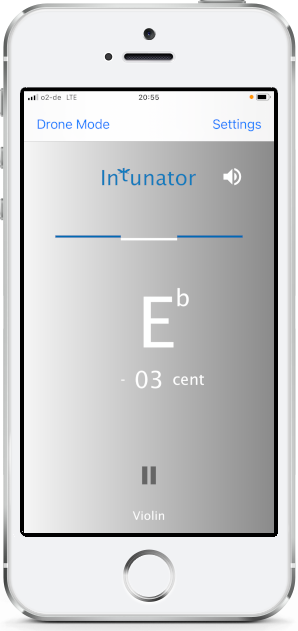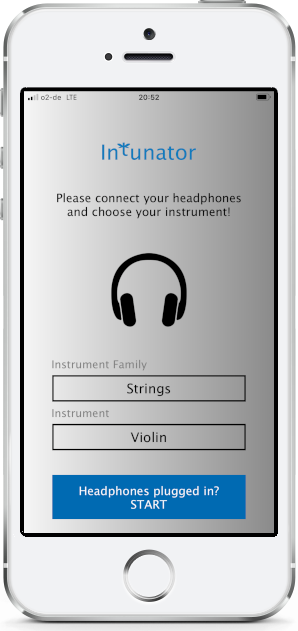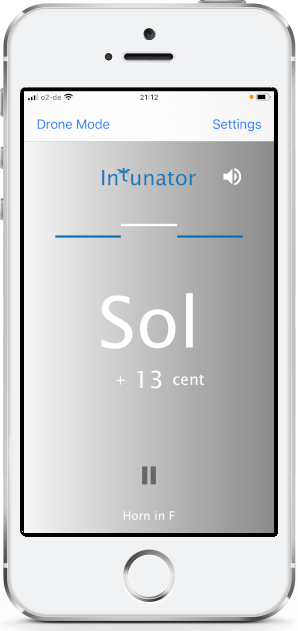FAQS
Which works better: cable or Bluetooth?
The Intunator performs best with a cable! The sound quality significantly decreases with Bluetooth transmission, and the response time increases.
Which headphones work best with the INTUNATOR?
Generally speaking, you can work with all types of headphones, both wired and Bluetooth.
The best type of headphones are so called "open headphones" that allow you to hear your instrument directly in your ear, and how it mixes with the sound being played by the INTUNATOR device.
In some circumstances it makes sense to leave one ear free of headphones.
A tip:
A tip for cable use: If you set the Background Noise to very low in the settings, you can even put your phone in your pocket during use. The sounds are still recognized and you can move around the room freely.
A tip for Bluetooth use: You can also place your phone somewhere in the room and then select the ambient volume in the settings so that the sound detection still works well. The quieter the setting, the more sensitive the sound detection.
Is it possible to use the INTUNATOR without headphones?
In order to improve your intonation while using INTUNATOR, hearing the control tone is essential.
However, you can use the INTUNATOR without headphones as a
professional tuner. It is accurate for a range of almost 7 octaves. You must press the Sound Off button on the cell phone, because
otherwise it will record its own sound, which can cause it to become hung up on a particular sound. We recommend against using your cell phone's speakers with the INTUNATOR app for this reason.
However, the control tone can also be heard via an external speaker, both wired and via Bluetooth. In this case, however, you must set the Background Noise to very loud in the settings so that INTUNATOR only recognizes you and not the speaker signal.
Can I practice my singing with the INTUNATOR?
Yes, this is now possible.
You can choose between soprano, alto, tenor and bass. First, turn off the Control Note (press the tone off button), so that INTUNATOR shows you a reliable tuner for the notes you are singing, either using note names (CDE) or solfege (do, re, mi) note names. With the control note, you can train your intonation by ear. You can choose between equal, fifth offset and octave offset pitch. The Drone Mode offers you, the singer, the additional option of improvising over your chosen sustained note. You may also do scale exercises. Your notes are displayed in relation to the heard fundamental as scale steps (1,2,3...) or solfege steps (do,re,mi…).
Can I also use the INTUNATOR to improve my intonation using the just scale?
Yes, you can! In the Drone Mode, you can choose between equal temperament and pure temperament. In this mode, a fundamental tone is set that can be heard as a sustained note (also called a drone). You can then play freely over it in this key and hear all your notes in relation to that note and in harmony with the set fundamental tone. The display supports you visually with the recognized scale steps, either in step
numbers (1,2,3...) or with Solfege (do, re, mi…) names. The
possibility of switching between the two tuning systems allows a direct comparison between the temperaments. This is especially interesting and impressive with thirds and sixths.
Why is the note that being played in the headphones sometimes an octave higher than the one I am playing?
The pitch detection
algorithm of the
INTUNATOR was perfected so that it recognizes and replays the note at the proper pitch for all instruments over a range of nearly seven octaves.
However, sometimes overtones of the pitch being played affect the ability of the
INTUNATOR to correctly recognize the note. This results in the octave (1st harmonic) playing louder than the actual note being played.
In these rare circumstances, the octave is played rather than the desired note (sometimes also the fifth, 2nd harmonic).
Consider the resulting intonation exercise with the octave or fifth as an additional training method on your path toward perfect intonation.
How does the background noise setting work?
The recommended default setting is normal background noise.
The quieter the setting, the more sounds and external noises will be picked up by INTUNATOR. If you want to carry your mobile device on your person while using the App (in your pants or shirt pocket, for example), or place the device at a greater distance from you, choose a quiet setting so that it can pick up as much sound as possible.
If you want to carry your mobile device on your person while using the App (in your pants or shirt pocket, for example), or place the device at a greater distance from you, choose a quiet setting so that it can pick up as much sound as possible.
If there is a lot of
background noise, please choose either the loud or very loud setting. Fewer signals will be picked up, and you can visually check your intonation while playing in the orchestra or big band.
What does the default setting of 442 Hertz mean and what happens when changes are made to this setting?
In order to play together with other musicians or in a "Play Along" scenario, it is necessary to use the same concert pitch for all instruments.
This concert pitch is determined by the so-called standard pitch "A", which generally lies between 440 and 444 Hertz.
The standard pitch frequency determines the relationship of all the other notes to each other as well.
Most orchestras these days tune to at least 442 Hertz, which is why we have chosen that as our default setting for the App.
What information does the INTUNATOR's display setting give the user?
Main Mode:
The notes being played are displayed by name. In addition, all possible transpositions of notes are given in the Choice of Instruments, for example B flat for trumpet or E flat for alto saxophone. Deviations from the desired pitch are shown graphically with a white line. Additionally, you can also choose to have the Display show the exact number of cents deviation. High line means high intonation, low line means low intonation. If the white line is level with the two blue lines, you have perfect intonation. You may also choose to activate an option which allows you to show the exact frequency played in Hertz.
Drone Mode:
In the Drone Mode, the detected notes are displayed in relation to the selected fundamental as scale number steps 1-2-3 or as Solfege steps (do, re, mi...). Here, too, you can read your exact intonation from the white line between the two blue ones.
How does the pitch detection number work?
The complex pitch detection settings of the App are optimized so that all notes can be recognized for every instrument.
This is particularly important for lower pitched notes.
Every instrument is assigned an individual pitch detection number according to its pitch range.
If for some reason the lowest notes on your instrument are not being recognized, please choose a smaller pitch detection in your instrument settings.
What operating system does my handheld device require in order to be able to run the APP?
To what extent can INTUNATOR keep up with me when I play quickly?
The INTUNATOR, with its unique ability to monitor your playing via your ear, has been developed to the very edge of what is technically possible.
The result is overwhelming.
Whether you are playing a single note, an etude or a piece of music, you can freely play and be constantly accompanied by the INTUNATOR.
It takes a relatively quick tempo to reach the technical limitations of the INTUNATOR.
The basic reason for the App must, however, be emphasized at this point. It has been designed to support the improvement of intonation by helping you to train your ear.
And with that in mind, the INTUNATOR offers a very comfortable and unique play along tempo.
(Tempo range: 80 - 140, depending on your instrument, operating system and cell phone model)
Is it possible to test the App free of charge?
INTUNATOR STARTUP can be tested in the IOS version free of charge and in its entirety (Intonation Trainer incl. Tuner Pro) for 4 weeks, after which you may choose to purchase or rent the app.
The TUNER PRO without control tone is available for 2 weeks free of charge for testing.
For Android, this possibility of renting and free testing is unfortunately still in the planning stages. If you don't like INTUNATOR, you can return the app within 2 days (48 hours) on the Google Play Store after purchase, according to Google guidelines.
What influence does the default setting have on the "Assistant"?
There are two settings that are automatically chosen with the help of the App's "Assistant": the transposition of the notes and the optimal pitch detection number for every instrument.
The pitch detection number guarantees the recognition of pitch for the entire spectrum of sound for the selected instrument.











